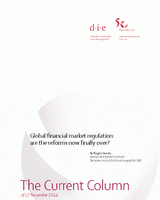Global financial market regulation: are the reforms now finally over?
Schmitz, BirgitThe Current Column (2014)
Bonn: German Development Institute / Deutsches Institut für Entwicklungspolitik (DIE) (The Current Column of 17 November 2014)
Bonn, 17 November 2014. The G20 summit was held in Brisbane, Australia on 15 and 16 November 2014. It was supposed to represent a milestone in terms of the successful conclusion of the global financial market reforms introduced in the wake of the 2008/2009 financial crisis. Consequently, Chairman of the Financial Stability Board Mark Carney titled his official letter to the G20 Finance Ministers and Central Bank Governors "Financial Reforms – Completing the job and looking ahead". Indeed, it is true that a great deal has happened since 2008. Even if we focus solely on the narrower area of banking regulation, there are a number of new developments, including higher risk-weighted capital ratios, countercyclical capital buffers, a leverage ratio, a liquidity coverage ratio, risk buffers for systemically important institutions, and measures for global and national systemically important banks. Every conceivable risk is being taken into account and it appears that all bases have been covered. But are these reforms sufficient for establishing a resilient financial system, and do they boost public confidence in the banking sector? Will the new rules provide a level playing field for internationally active banks? That depends.
The G20 continues to stress that a stable financial system is essential for achieving strong, sustainable and balanced growth. Everybody was in agreement in 2008 that well coordinated, collective action was needed in order to overcome the crisis and reduce the vulnerability of the financial system in future. Consequently, the Financial Stability Board and the Bank for International Settlements' Basel Committee on Banking Supervision (BCBS) were tasked with analysing weaknesses in the system and drawing up relevant banking regulation reforms. Since 2008, both bodies have reported regularly on the reform projects and the status of their implementation. However, it is evident from the reports and background analyses that there is still a long way to go in achieving the reform objectives of resilient banking, the restoration of public confidence and the provision of a level playing field.
Whether all aspects of the reforms have been completed already and whether the new requirements have been adopted in national law and entered into force are of secondary importance. The crucial matter is how much progress has been made in implementing the reforms at national level and how the banking sector has responded to the new regulations so far. The BCBS' current Monitoring Report reveals that there is still a great disparity between the objectives and reality. It looked at 227 banks in BCBS member countries, including 102 Group 1 banks (those that have at least EUR 3 billion of capital). This group accounts for close to 100% of the banking sector in the respective countries and all 29 of the banks so far identified as systemically important at global level. The BCBS members comprise the largest and most important financial systems, including emerging economies. The member countries examined are leading the way in the reforms because they are the ones drawing up the banking regulations and committing themselves to their implementation.
This makes it all the more astonishing that around 10% of the banks examined are failing to comply with the 3% leverage ratio and that 18% of banks are not achieving the stipulated 8.5% risk-weighted minimum equity ratio. Around one fifth of banks are currently experiencing problems with at least one of the two standards. As such, it is hardly reassuring to know that the leverage ratio has not yet entered fully into force or that the banks are still at the stage of adjusting to the new risk-weighted equity ratios. Six years on from the financial crisis, it should be clear to all stakeholders that the capital, that is, the risk buffer, available to a bank to make up for losses in a crisis must be far greater. The leverage ratio is actually designed to cover the absolute minimum threshold and is intended as as simple backstop to the risk-based requirements, providing a safety net underneath the risks to a bank's balance sheet. These results cannot really be expected to boost confidence in the banking sector nor in its willingness to reform.
There is more disconcerting news from other areas of the reforms' implementation. The BCBS reports that significant variation is emerging in assessments when it comes to calculating the risk weighting of a hypothetical test portfolio. Differences in the way that the rules are implemented and applied are preventing comparability across borders, which in turn is calling into question the provision of a level playing field for internationally active banks.
So, what is the key issue at stake in the decisions taken by the G20 in Brisbane? The reforms must be implemented in a timely manner. This was one of the priorities agreed by the G20 members. It is now a case of ensuring that the new regulations are applied consistently and that there is ongoing scrutiny of regulatory outcomes. This is the only way to ensure that the reforms take effect and help to get stable global financial systems up and running.
